Backups
In OpenPanel, backups are configurable directly by the panel users, unlike other panels where backups are managed by the admin.
This empowers users to define their own backup schedules, choose exactly what to back up, and select from a wide range of supported destinations. As a result, administrators have fewer tasks to manage, and users gain greater control and flexibility.
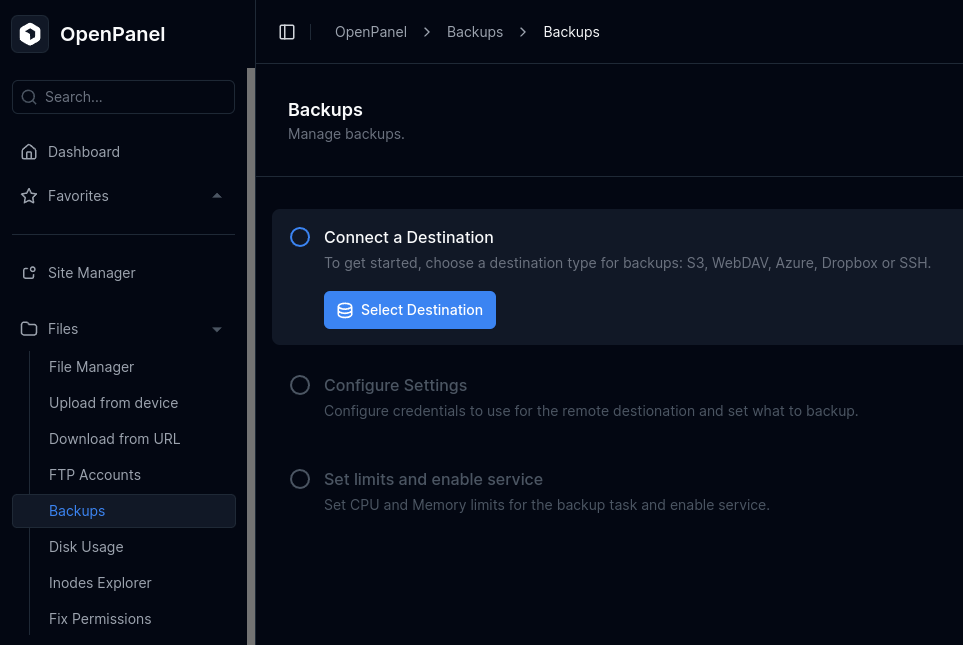
Destinations
OpenPanel supports the following destinations:
- S3 storage - AWS S3, Filebase, MinIO, etc.
- WebDAV - Remote backups using WebDAV.
- SSH - Remote backups via SSH to another server.
- Azure - Remote backups to Azure Blob Storage.
- Dropbox - Remote backups to Dropbox cloud storage.
User can select destination from Backups > Destinations page.
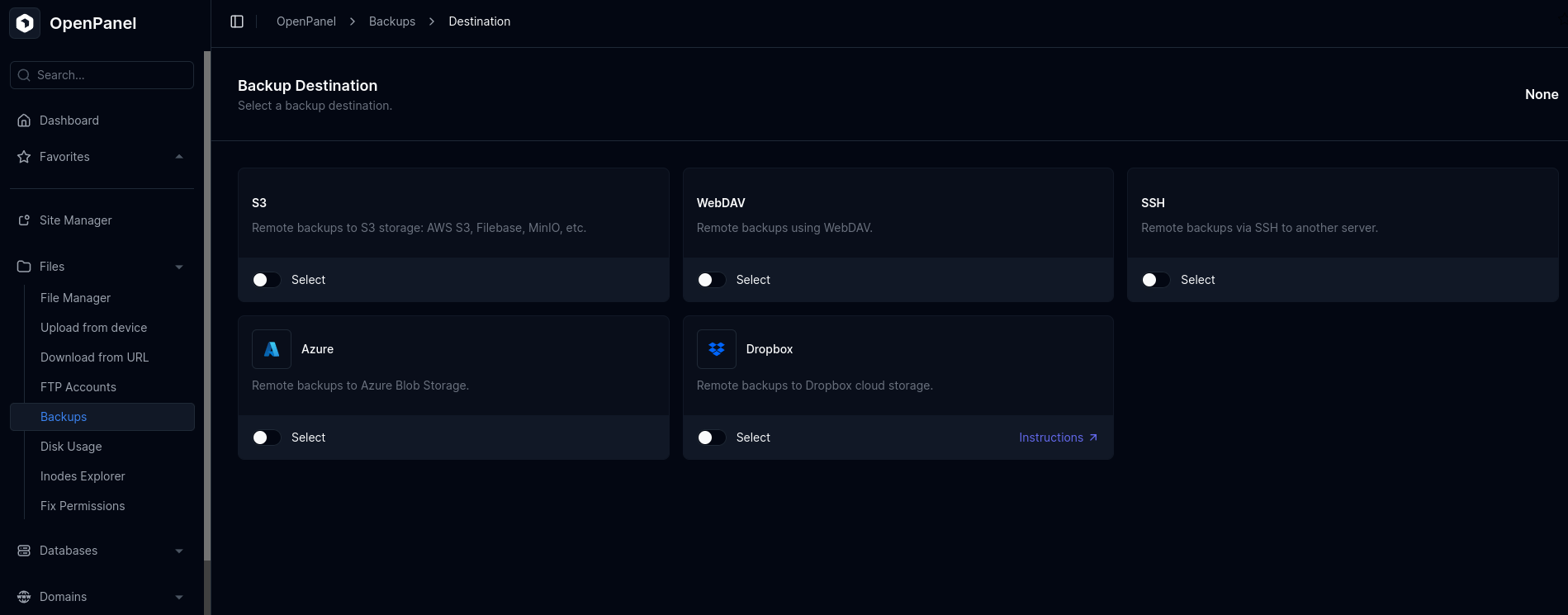
Once backup is selected, it's options are available on Backups > Settings page.
SSH/SFTP
| Setting | Description |
|---|---|
| SSH_HOST_NAME | The FQDN of the remote SSH server, example: server.local |
| SSH_PORT | The port of the remote SSH server |
| SSH_REMOTE_PATH | The Directory to place the backups to on the SSH server. Example: /home/user/backups |
| SSH_USER | The username for the SSH server. Example: user |
| SSH_PASSWORD | The password for the SSH server. Example: password |
| SSH_IDENTITY_FILE | The private key path inside /var/www/html/ for SSH server. Non-RSA keys (e.g. ed25519) will also work. |
| SSH_IDENTITY_PASSPHRASE | The passphrase for the identity file if applicable. Example: pass |
S3
| Setting | Description |
|---|---|
| AWS_S3_BUCKET_NAME | The name of the remote bucket that should be used for storing backups. If this is not set, no remote backups will be stored. Example: backup-bucket |
| AWS_S3_PATH | If you want to store the backup in a non-root location on your bucket you can provide a path. The path must not contain a leading slash. Example: my/backup/location |
| AWS_ACCESS_KEY_ID AWS_SECRET_ACCESS_KEY | Define credentials for authenticating against the backup storage and a bucket name. Although all of these keys are AWS-prefixed, the setup can be used with any S3 compatible storage. |
| AWS_IAM_ROLE_ENDPOINT | Instead of providing static credentials, you can also use IAM instance profiles or similar to provide authentication. Some possible configuration options on AWS: - EC2: http://169.254.169.254 - ECS: http://169.254.170.2 |
| AWS_ENDPOINT | This is the FQDN of your storage server, e.g. storage.example.com. If you need to set a specific (non-https) protocol, you will need to use the AWS_ENDPOINT_PROTO option. The default value points to the standard AWS S3 endpoint. Example: s3.amazonaws.com |
| AWS_ENDPOINT_PROTO | The protocol to be used when communicating with your S3 storage server. Defaults to "https". You can set this to "http" when communicating with a different seld-hosted s3 storage. |
| AWS_ENDPOINT_INSECURE | Setting this variable to true will disable verification of SSL certificates for AWS_ENDPOINT. You shouldn't use this unless you use self-signed certificates for your remote storage backend. This can only be used when AWS_ENDPOINT_PROTO is set to https. |
| AWS_ENDPOINT_CA_CERT | If you wish to use self signed certificates your S3 server, you can pass the location of a PEM encoded CA certificate and it will be used for validating your certificates. Alternatively, pass a PEM encoded string containing the certificate. Example: /var/www/html/cert.pem |
| AWS_STORAGE_CLASS | Setting a value for this key will change the S3 storage class header. Default behavior is to use the standard class when no value is given. Example: GLACIER |
| AWS_PART_SIZE | Setting this variable will change the S3 default part size for the copy step. This value is useful when you want to upload large files. Note: While using Scaleway as S3 provider, be aware that the parts counter is set to 1.000. While Minio uses a hard coded value to 10.000. As a workaround, try to set a higher value. Defaults to 16 (MB) if unset (from minio), you can set this value according to your needs. The unit is in MB and an integer. |
WebDAV
| Setting | Description |
|---|---|
| WEBDAV_URL | The URL of the remote WebDAV server. Example: https://webdav.example.com |
| WEBDAV_PATH | The Directory to place the backups to on the WebDAV server. If the path is not present on the server it will be created. Example: /my/directory/ |
| WEBDAV_USERNAME | The username for the WebDAV server Example: user |
| WEBDAV_PASSWORD | The password for the WebDAV server. Example: password |
| WEBDAV_URL_INSECURE | Setting this variable to "true" will disable verification of SSL certificates for WEBDAV_URL. You shouldn't use this unless you use self-signed certificates for your remote storage backend. |
Azure
| Setting | Description |
|---|---|
| AZURE_STORAGE_ACCOUNT_NAME | The credential's account name when using Azure Blob Storage. This has to be set when using Azure Blob Storage. Example: account-name |
| AZURE_STORAGE_PRIMARY_ACCOUNT_KEY | The credential's primary account key when using Azure Blob Storage. If this is not given, the command tries to fall back to using a connection string (if given) or a managed identity (if neither is set). |
| AZURE_STORAGE_CONNECTION_STRING | A connection string for accessing Azure Blob Storage. If this is not given, the command tries to fall back to using a primary account key (if given) or a managed identity (if neither is set). |
| AZURE_STORAGE_CONTAINER_NAME | The container name when using Azure Blob Storage. Example: container-name |
| AZURE_STORAGE_ENDPOINT | The service endpoint when using Azure Blob Storage. This is a template that can be passed the account name. Example: https://{{ .AccountName }}.blob.core.windows.net/ |
| AZURE_STORAGE_ACCESS_TIER | The access tier when using Azure Blob Storage. Possible values are listed here Example: Cold |
Dropbox
| Setting | Description |
|---|---|
| DROPBOX_REMOTE_PATH | Absolute remote path in your Dropbox where the backups shall be stored. Note: Use your app's subpath in Dropbox, if it doesn't have global access. Example: /my/directory |
| DROPBOX_APP_KEY DROPBOX_APP_SECRET | App key and app secret from your app created at https://www.dropbox.com/developers/apps |
| DROPBOX_CONCURRENCY_LEVEL | Number of concurrent chunked uploads for Dropbox. Values above 6 usually result in no enhancements. |
| DROPBOX_REFRESH_TOKEN | Refresh token to request new short-lived tokens (OAuth2) |
Set up Dropbox storage backend:
- Create a new Dropbox App in the App Console
- Open your new Dropbox App and copy the
DROPBOX_APP_KEYandDROPBOX_APP_SECRET - Click on
Permissionsin your app and make sure, that the following permissions are cranted (or more):files.metadata.writefiles.metadata.readfiles.content.writefiles.content.read
- Replace APPKEY in
https://www.dropbox.com/oauth2/authorize?client_id=APPKEY&token_access_type=offline&response_type=codewith the app key from step 2 - Visit the URL and confirm the access of your app. This gives you an
auth code-> save it somewhere! - Replace AUTHCODE, APPKEY, APPSECRET accordingly and perform the request from your terminal:
curl https://api.dropbox.com/oauth2/token \
-d code=AUTHCODE \
-d grant_type=authorization_code \
-d client_id=APPKEY \
-d client_secret=APPSECRET - Execute the request. You will get a JSON formatted reply. Use the value of the
refresh_tokenfor the last settingDROPBOX_REFRESH_TOKEN - You should now have
DROPBOX_APP_KEY,DROPBOX_APP_SECRETandDROPBOX_REFRESH_TOKENset. These don’t expire.
Note: Using the “Generated access token” in the app console is not supported, as it is only very short lived and therefore not suitable for an automatic backup solution. The refresh token handles this automatically - the setup procedure above is only needed once.
Important: If you chose App folder access during the creation of your Dropbox app in step 1 above, DROPBOX_REMOTE_PATH will be a relative path under the App folder! (For example, DROPBOX_REMOTE_PATH=/somedir means the backup file will be uploaded to /Apps/myapp/somedir) On the other hand if you chose Full Dropbox access, the value for DROPBOX_REMOTE_PATH will represent an absolute path inside your Dropbox storage area. (Still considering the same example above, the backup file will be uploaded to /somedir in your Dropbox root)
Encryption
Backup encryption is by default disabled and needs to be enabled by the Administrator first.
All of the encryption options are mutually exclusive. Provide a single option for the encryption scheme of your choice.
| Setting | Description |
|---|---|
| GPG_PASSPHRASE | Backups can be encrypted symmetrically using gpg in case a passphrase is given. |
| GPG_PUBLIC_KEY_RING | Backups can be encrypted asymmetrically using gpg in case publickeys are given. You can use pipe syntax to pass a multiline value. |
| AGE_PASSPHRASE | Backups can be encrypted symmetrically using age in case a passphrase is given. |
| AGE_PUBLIC_KEYS | Backups can be encrypted asymmetrically using age in case publickeys are given. Multiple keys need to be provided as a comma separated list. Right now, this supports age and ssh keys. |
Rotation
IMPORTANT, PLEASE READ THIS BEFORE USING THIS FEATURE:
The mechanism used for pruning old backups is not very sophisticated and applies its rules to all files in the target directory by default, which means that if you are storing your backups next to other files, these might become subject to deletion too. When using this option make sure the backup files are stored in a directory used exclusively for such files, or to configure BACKUP_PRUNING_PREFIX to limit removal to certain files.
| Setting | Description |
|---|---|
| BACKUP_RETENTION_DAYS | Pass zero or a positive integer value to enable automatic rotation of old backups. The value declares the number of days for which a backup is kept. Default: -1 |
| BACKUP_PRUNING_LEEWAY | In case the duration a backup takes fluctuates noticeably in your setup you can adjust this setting to make sure there are no race conditions between the backup sit on the edge of the time window. Set this value to a duration finishing and the rotation not deleting backups that that is expected to be bigger than the maximum difference of backups. Valid values have a suffix of (s)econds, (m)inutes or (h)ours. By default, one minute is used. |
| BACKUP_PRUNING_PREFIX | In case your target bucket or directory contains other files than the ones managed by this container, you can limit the scope of rotation by setting a prefix value. This would usually be the non-parametrized part of your BACKUP_FILENAME. E.g. if BACKUP_FILENAME is db-backup-%Y-%m-%dT%H-%M-%S.tar.gz, you can set BACKUP_PRUNING_PREFIX to db-backup- and make sure unrelated files are not affected by the rotation mechanism. |
Source
By default, everything will be backed up. In case you need to backup only a specific data, set BACKUP_SOURCES.
Available options are:
| Setting | Description |
|---|---|
| All | Backups content of all docker volumes: website files, mysql/mariadb databases, minecraft, postgre databases, vhosts files. |
| Files | Backups only website files inside /var/www/html/ directory. |
| Emails | Backups only email files inside /var/mail/ directory. |
| MySQL Databases | Backups only MySQL/MariaDB databases. |
| Postgres Databases | Backups only PostgreSQL databases. |
| MsSQL Databases | Backups only MsSQL databases. |
| VirtualHosts | Backups only Apache/Nginx VirtualHosts for domains. |
| Minecraft Data | Backups only /data folder from Minecraft container. |
Schedule
Backups can be run on fixed scheduled that are defined as a cron expression.
BACKUP_CRON_EXPRESSION is used to schedule the backup job, a cron expression represents a set of times, using 5 or 6 space-separated fields.
| Field name | Mandatory? | Allowed values | Allowed special characters |
|---|---|---|---|
| Seconds | No | 0-59 | * / , - |
| Minutes | Yes | 0-59 | * / , - |
| Hours | Yes | 0-23 | * / , - |
| Day of month | Yes | 1-31 | * / , - ? |
| Month | Yes | 1-12 or JAN-DEC | * / , - |
| Day of week | Yes | 0-6 or SUN-SAT | * / , - ? |
Month and Day-of-week field values are case insensitive. "SUN", "Sun", and "sun" are equally accepted. Refer to sites like crontab.guru for help.
If no value is set, @daily will be used, which runs every day at midnight.
Compression
| Setting | Description |
|---|---|
BACKUP_COMPRESSION | The compression algorithm used in conjunction with tar. Valid options are: "gz" (Gzip), "zst" (Zstd) or "none" (tar only). Default is "gz". Note that the selection affects the file extension. |
GZIP_PARALLELISM | Parallelism level for "gz" (Gzip) compression. Defines how many blocks of data are concurrently processed. Higher values result in faster compression. No effect on decompression. Default = 1. Setting this to 0 will use all available threads. |
Names
Options here are available byt disabled by default and need to be manually enabled by the Administrator first.
| Setting | Description |
|---|---|
BACKUP_FILENAME | The desired name of the backup file including the extension. Format verbs will be replaced as in strftime. Omitting all verbs will result in the same filename for every backup run, which means previous versions will be overwritten on subsequent runs. Extension can be defined literally or via {{ .Extension }} template, in which case it will become either "tar.gz", "tar.zst" or ".tar" (depending on your BACKUP_COMPRESSION setting). The default backup-%Y-%m-%dT%H-%M-%S.{{ .Extension }} results in filenames like: backup-2021-08-29T04-00-00.tar.gz. |
Exclude
BACKUP_EXCLUDE_REGEXP - When a value is given, all files in BACKUP_SOURCES whose full path matches the regular expression will be excluded from the archive. Regular Expressions can be used as from the Go standard library. Example: \.log$.
Notifications
Notifications (email, Slack, etc.) can be sent out when a backup run finishes.
NOTIFICATION_URLS
Configuration is provided as a comma-separated list of URLs as consumed by shoutrrr
| Service | URL format |
|---|---|
| Bark | bark://devicekey@host |
| Discord | discord://token@id |
smtp://username:password@host:port/?from=fromAddress&to=recipient1[,recipient2,...] | |
| Gotify | gotify://gotify-host/token |
| Google Chat | googlechat://chat.googleapis.com/v1/spaces/FOO/messages?key=bar&token=baz |
| IFTTT | ifttt://key/?events=event1[,event2,...]&value1=value1&value2=value2&value3=value3 |
| Join | join://shoutrrr:api-key@join/?devices=device1[,device2,...][&icon=icon][&title=title] |
| Mattermost | mattermost://[username@]mattermost-host/token[/channel] |
| Matrix | matrix://username:password@host:port/[?rooms=!roomID1[,roomAlias2]] |
| Ntfy | ntfy://username:password@ntfy.sh/topic |
| OpsGenie | opsgenie://host/token?responders=responder1[,responder2] |
| Pushbullet | pushbullet://api-token[/device/#channel/email] |
| Pushover | pushover://shoutrrr:apiToken@userKey/?devices=device1[,device2,...] |
| Rocketchat | `rocketchat://[username@]rocketchat-host/token[/channel |
| Slack | slack://[botname@]token-a/token-b/token-c |
| Teams | teams://group@tenant/altId/groupOwner?host=organization.webhook.office.com |
| Telegram | telegram://token@telegram?chats=@channel-1[,chat-id-1,...] |
| Zulip Chat | zulip://bot-mail:bot-key@zulip-domain/?stream=name-or-id&topic=name |
Email
URL Format:
smtp://username:password@host:port/?from=fromAddress&to=recipient1[,recipient2,...]
URL Fields:
Username – SMTP server username
Default: empty
URL part:smtp://username:password@host:port/Password – SMTP server password or hash (for OAuth2)
Default: empty
URL part:smtp://username:password@host:port/Host – SMTP server hostname or IP address (Required)
URL part:smtp://username:password@host:port/Port – SMTP server port
Common values: 25, 465, 587, 2525
Default:25
URL part:smtp://username:password@host:port/
Query/Param Props:
Props can be supplied via the params argument or directly in the URL using ?key=value&key=value.
FromAddress – Email address the mail is sent from (Required)
Aliases:fromToAddresses – Comma-separated list of recipient emails (Required)
Aliases:toAuth – SMTP authentication method
Default:Unknown
Possible values:None,Plain,CRAMMD5,Unknown,OAuth2ClientHost – Hostname sent to the SMTP server during the HELO phase
Default:localhost
Set to"auto"to use OS hostnameEncryption – Encryption method
Default:Auto
Possible values:None,ExplicitTLS,ImplicitTLS,AutoFromName – Name of the sender
Default: emptySubject – Subject line of the email
Default:Shoutrrr Notification
Aliases:titleUseHTML – Whether the message is in HTML format
Default: ❌ NoUseStartTLS – Whether to use StartTLS encryption
Default: ✔ Yes
Aliases:starttls
Bark
URL Fields:
DeviceKey – The key for each device (Required)
URL part:bark://:devicekey@host/pathHost – Server hostname and port (Required)
URL part:bark://:devicekey@host/pathPath – Server path
Default:/
URL part:bark://:devicekey@host/path
Query/Param Props:
Props can be either supplied using the params argument, or through the URL using ?key=value&key=value etc.
Badge – The number displayed next to App icon
Default:0Category – Reserved field, no use yet
Default: emptyCopy – The value to be copied
Default: emptyGroup – The group of the notification
Default: emptyIcon – A URL to the icon, available only on iOS 15 or later
Default: emptyScheme – Server protocol,
httporhttps
Default:httpsSound – Value from Bark Sounds
Default: emptyTitle – Notification title, optionally set by the sender
Default: emptyURL – URL that will open when notification is clicked
Default: empty
Discord
URL Format:
discord://token@webhookid
URL Fields:
Token – (Required)
URL part:discord://token@webhookid/WebhookID – (Required)
URL part:discord://token@webhookid/
Query/Param Props:
Props can be either supplied using the params argument, or through the URL using ?key=value&key=value etc.
Avatar – Override the webhook default avatar with specified URL
Default: empty
Aliases:avatarurlColor – The color of the left border for plain messages
Default:0x50D9ffColorDebug – The color of the left border for debug messages
Default:0x7b00abColorError – The color of the left border for error messages
Default:0xd60510ColorInfo – The color of the left border for info messages
Default:0x2488ffColorWarn – The color of the left border for warning messages
Default:0xffc441JSON – Whether to send the whole message as the JSON payload instead of using it as the
contentfield
Default: ❌ NoSplitLines – Whether to send each line as a separate embedded item
Default: ✔ YesTitle
Default: emptyUsername – Override the webhook default username
Default: empty
Creating a Webhook in Discord:
- Open your channel settings by clicking the gear icon next to the channel name.
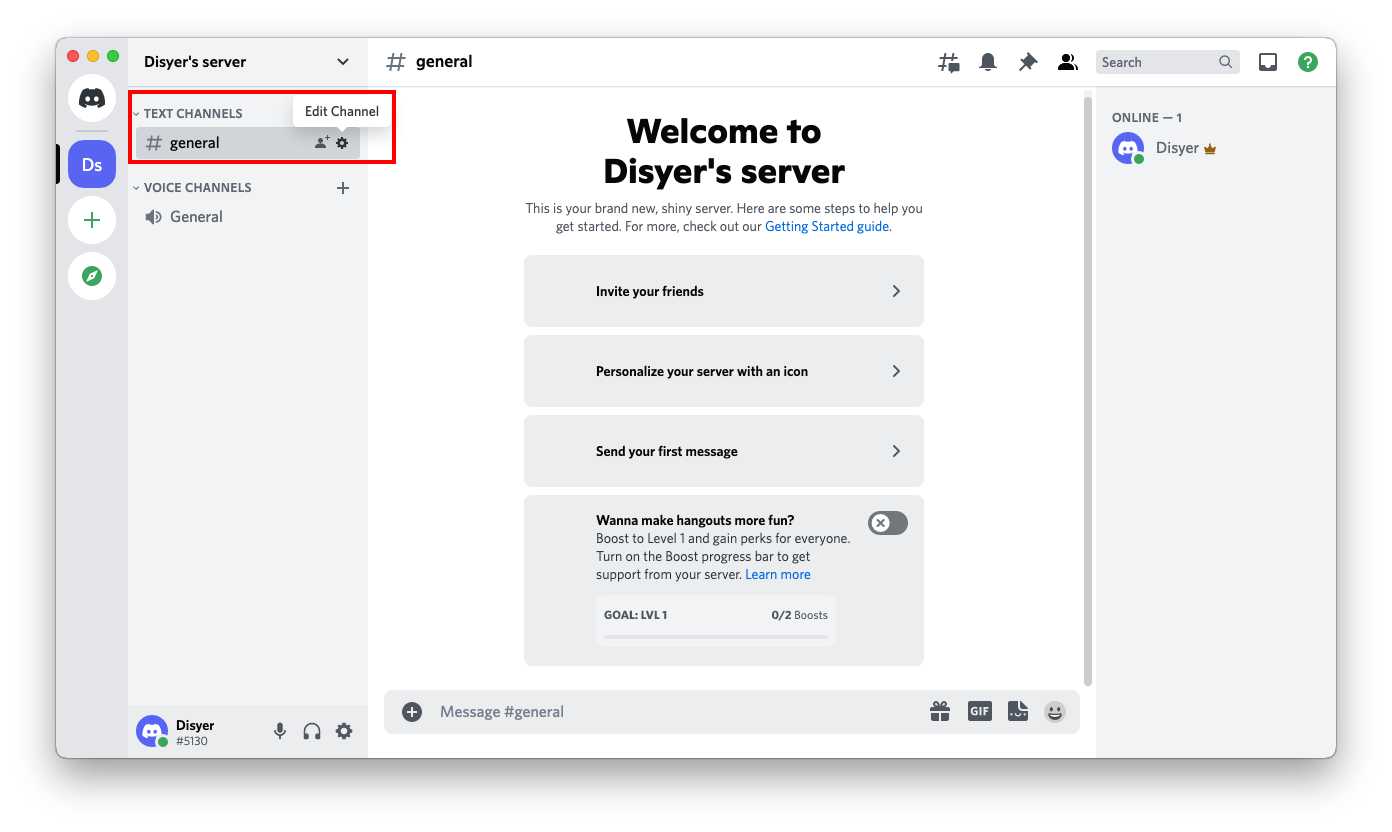
- In the left menu, click Integrations.
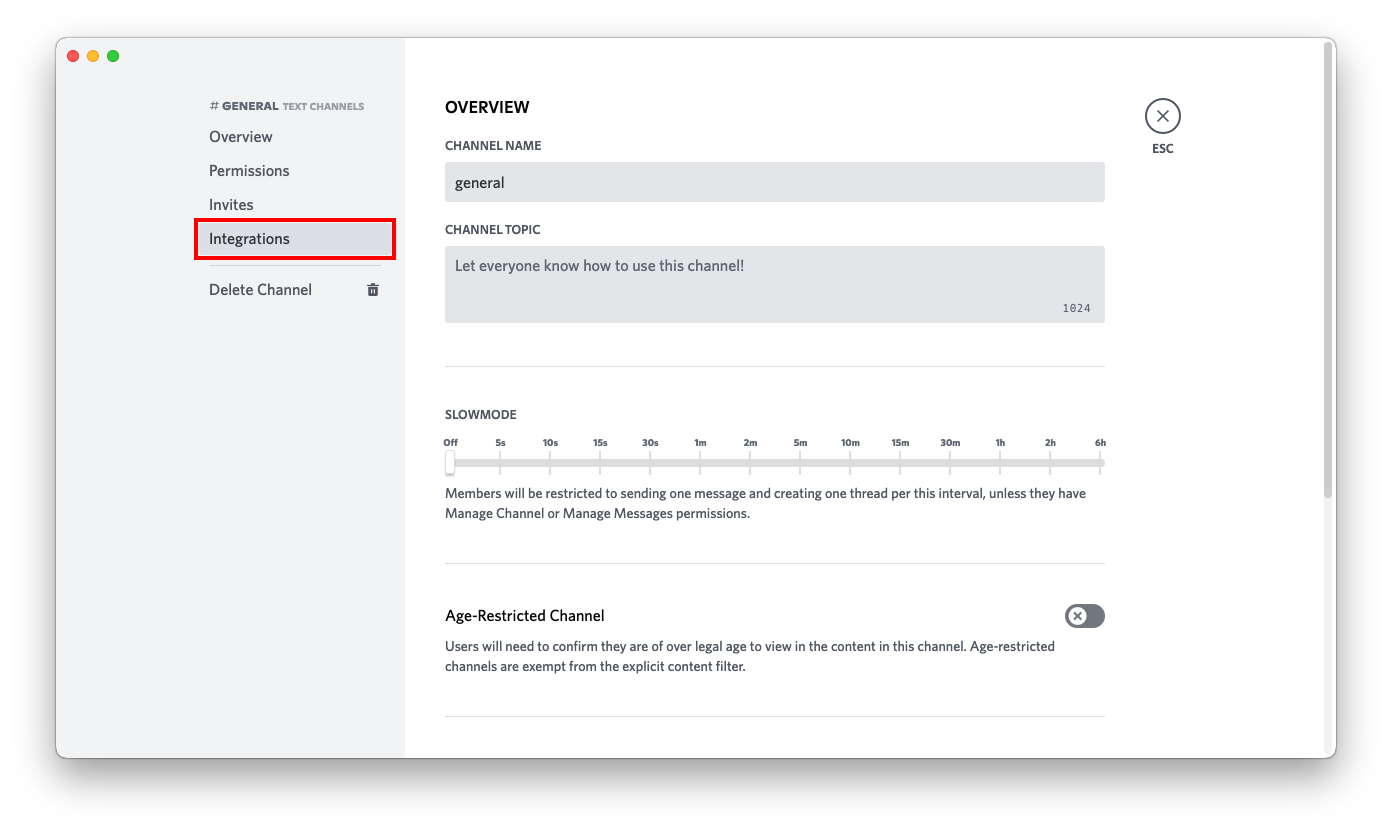
- On the right, click Create Webhook.
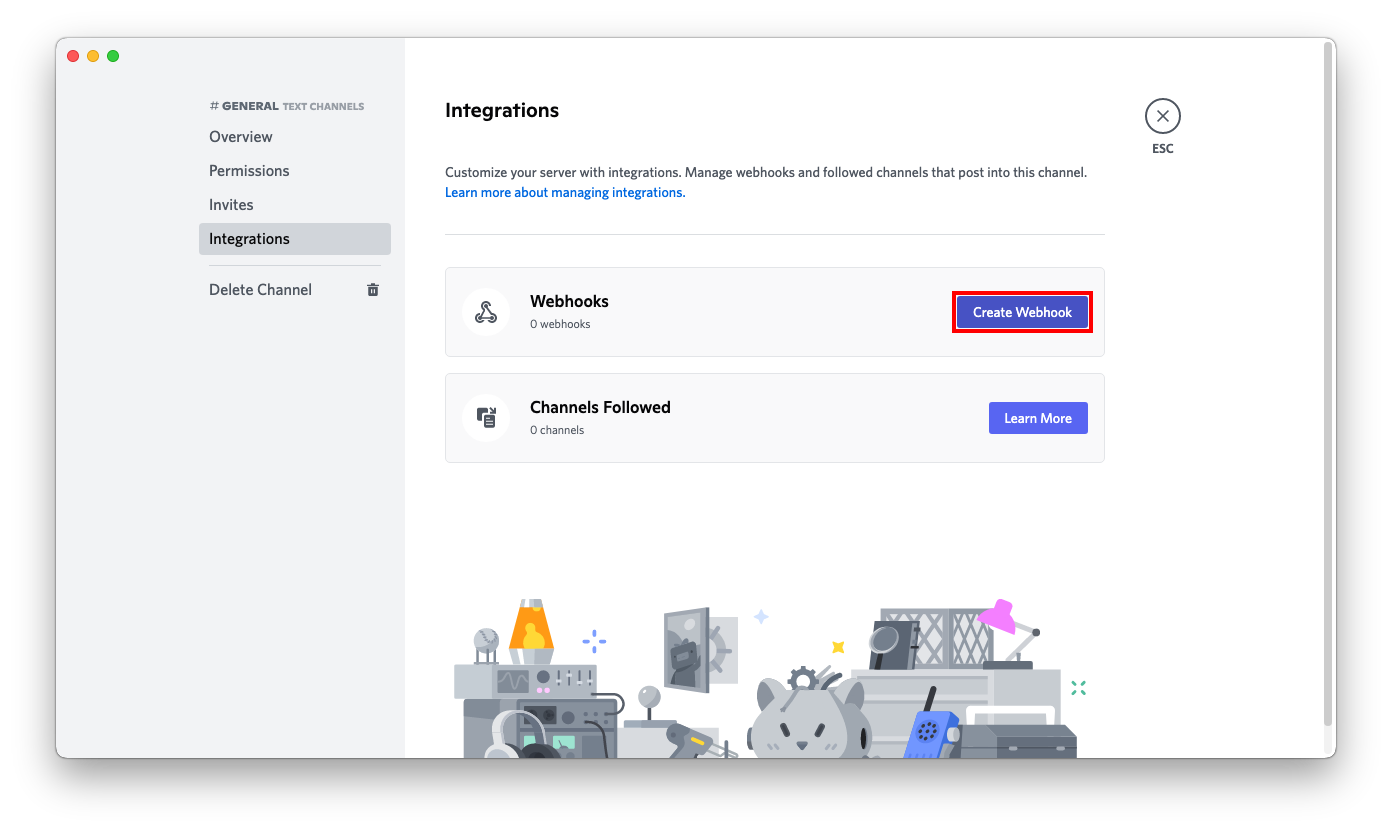
- Set the name, channel, and icon to your preference, then click Copy Webhook URL.

- Press Save Changes.
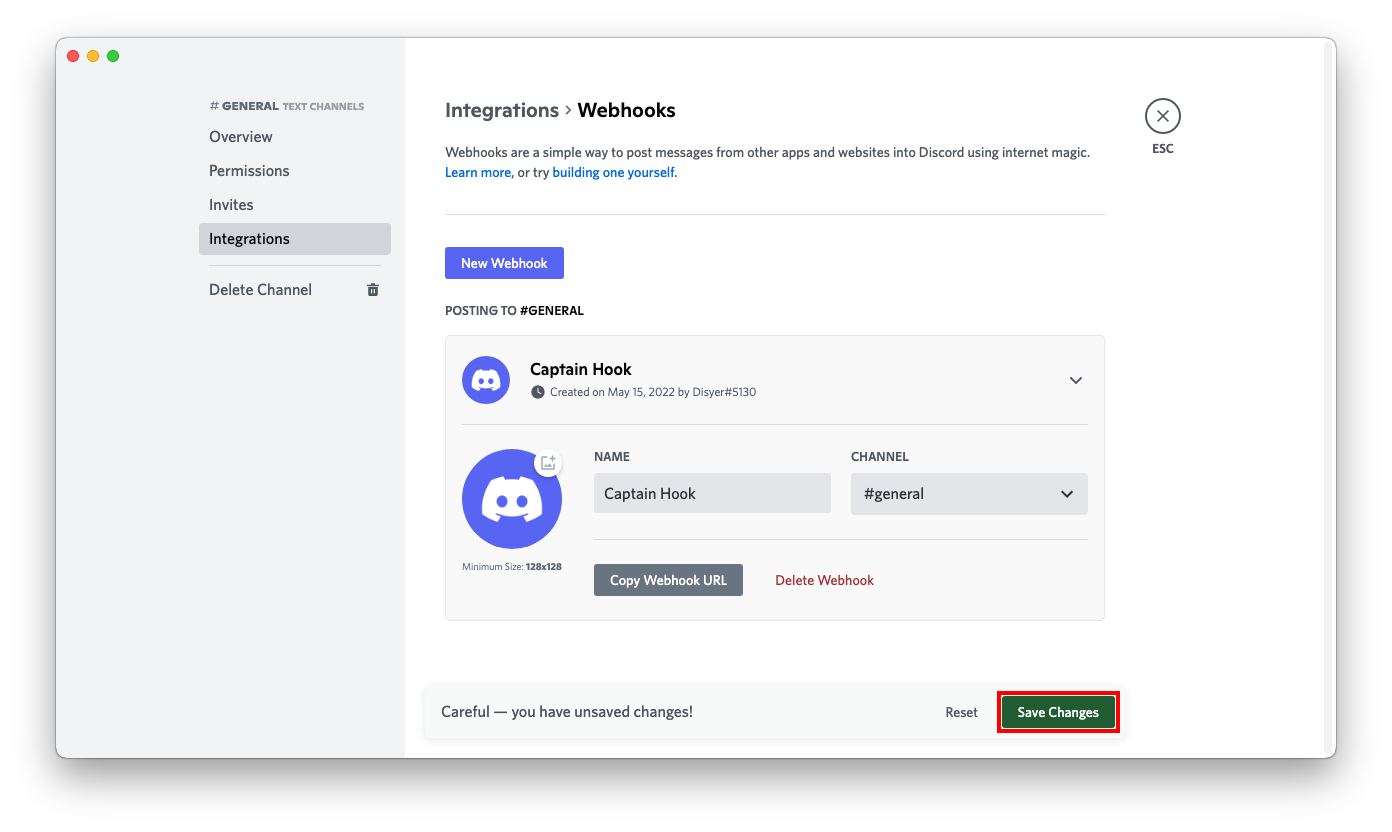 6 Format the service URL:
6 Format the service URL:https://discord.com/api/webhooks/693853386302554172/W3dE2OZz4C13_4z_uHfDOoC7BqTW288s-z1ykqI0iJnY_HjRqMGO8Sc7YDqvf_KVKjhJ
└────────────────┘ └──────────────────────────────────────────────────────────────────┘
webhook id token
discord://W3dE2OZz4C13_4z_uHfDOoC7BqTW288s-z1ykqI0iJnY_HjRqMGO8Sc7YDqvf_KVKjhJ@693853386302554172
└──────────────────────────────────────────────────────────────────┘ └────────────────┘
token webhook id
NOTIFICATION_LEVEL
By default, notifications would only be sent out when a backup run fails. To receive notifications for every run, set NOTIFICATION_LEVEL to info instead of the default error.
Triggering a Backup
You can manually trigger a backup at any time, regardless of the scheduled settings. To do this, ensure the Docker feature is enabled. Then:
- Navigate to Containers > Terminal.
- Select the Backup container.
- In the terminal, type the following command and press Enter:
backup
Troubleshooting
Error error copying archive: ssh.(sshStorage).Copy: error creating file: file does not exist* indicates that the configured directory does not exist on destination:
time=2025-07-22T11:21:05.117Z level=ERROR msg="Fatal error running command: file does not exist" error="main.(*command).runAsCommand: error running script: main.runScript.func4: error running script: main.(*script).copyArchive: error copying archive: ssh.(*sshStorage).Copy: error creating file: file does not exist"